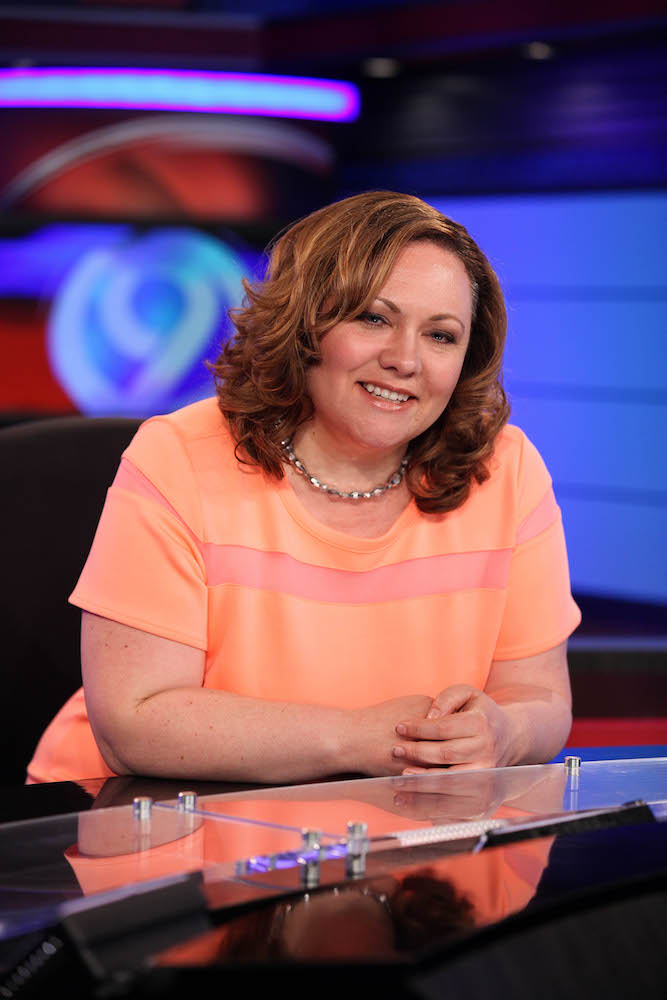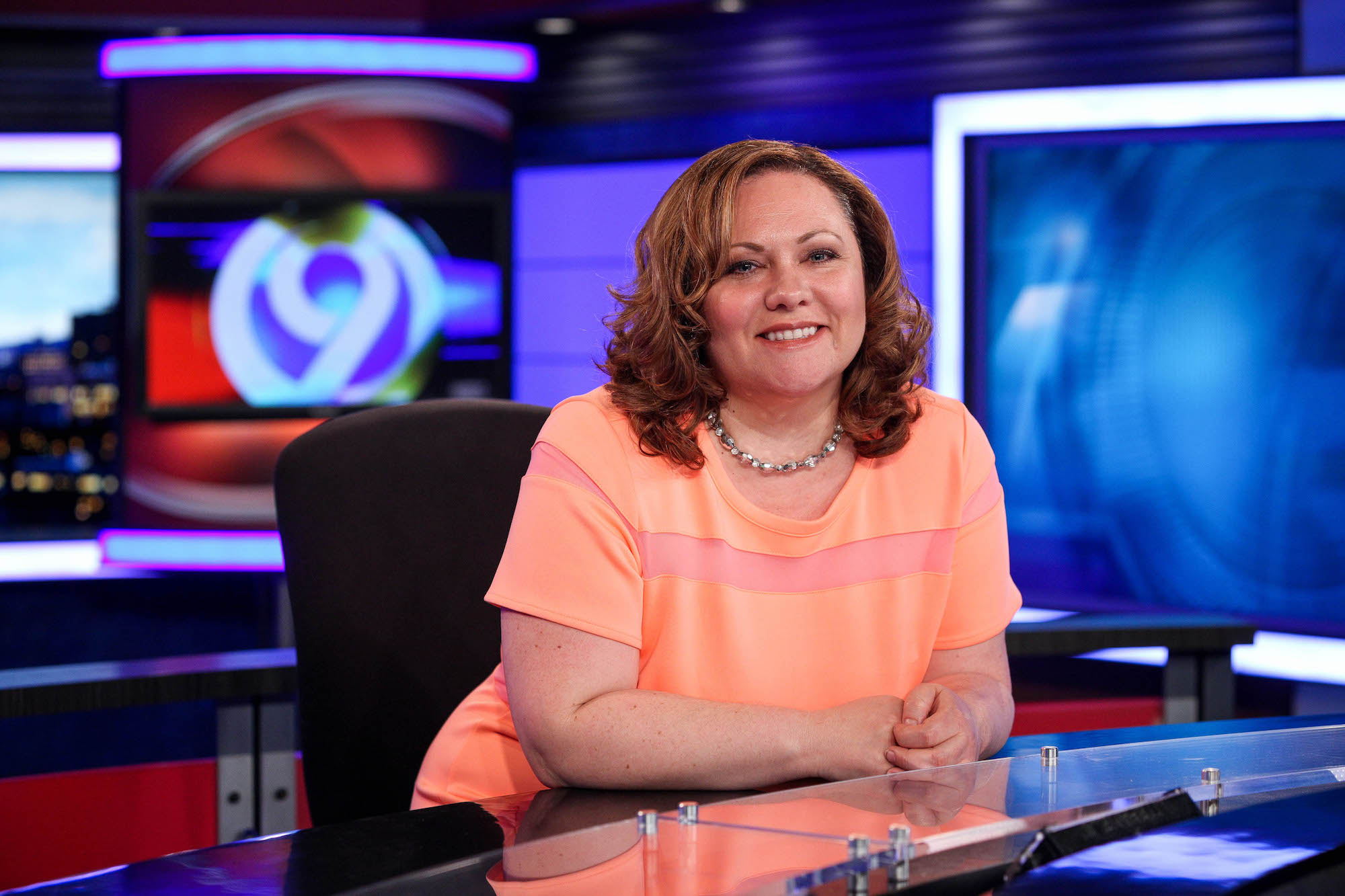
The WSYR-Channel 9 morning newscast on Sunday, Jan. 3, 2016, looked pretty much the same as it always did. Weekend anchor Tammy Palmer started the broadcast at 7 a.m. with a rundown of the previous day’s local and national events, followed by segments devoted to sports, weather, financial planning and other topics to fill the hour.
Then at around 8 a.m. Palmer was rushed by her producer to the emergency room at St. Joseph’s Hospital. Unbeknownst to viewers, Palmer endured intense physical pain during that hour, as the effects of her weeks-long struggle with ulcerative colitis were finally taking its toll.
And unbeknownst to Palmer, she would spend the next nine days at the hospital, with the first of her three procedures involving reconstructive surgery of her colon taking place Jan. 8. It would be several more months until Palmer would finally be free of her pain, her walking cane and her ostomy bag.
Palmer was on and off the airwaves throughout the spring of 2016, as she seesawed between maintaining a work schedule at Channel 9 yet also taking some absences to undergo, and recover from, two more surgeries. She never revealed her illness during the news broadcasts, although she detailed her events with ongoing Facebook posts, which caught the eyes of the organizers behind the annual Syracuse Take Steps for Crohn’s Disease and Colitis Walk. Both illnesses, which concern chronic inflammation of the gastrointestinal tract, affect more than 1.6 million people nationwide.

Tammy Palmer sits at the News Channel 9 news desk during a broadcast. Michael Davis photo
So they asked Palmer to captain a team and to share her experiences in order to raise awareness about a subject that many find difficult to discuss. The walk, which organizers hope will reach its $30,000 goal, will take place Saturday, June 17, 9 a.m., at Onondaga Lake Park in Liverpool. For information, call walk coordinator Eric Israel, (585) 967-0266, or email [email protected].
“This is my way to pay it forward,” says Palmer, who often handles the Your Stories segments regarding viewer tips about possible local scofflaws. “I know how important it was for me to talk to someone when I really needed to. So I agreed to spread the word about this walk and this organization, where you can meet other people going through the same thing.”
Palmer’s explanation of her colitis issue is not for the squeamish, however: “Your body’s immune system reacts to something and attacks the lining of your colon, and that creates ulcers and they bleed. And you’re constantly using that part of your body and you’re constantly irritating those bleeding wounds, and the blood just becomes more and more intense.”
Palmer was raised in Volney and attended Fulton schools, then went on to earn a mass communications degree from SUNY Oswego in 1998. She actually got her start in her chosen field while interning for Channel 9 during her senior year, but she took a few career detours along her early path, including a brief stint at the Nestle chocolate factory in Fulton.
“I had no idea what to do with that degree,” she recalls, “so after graduation and with my college summer job with Sealright (now the Huhtamaki packaging firm) coming to an end, I was part of the last group hired at Nestle, where my father worked for many years. It was hard work, cleaning the boiler rooms. I mopped up hot butter spills, scrubbed milk dust off the walls, and cleaned out giant vats of chocolate. But the newbies were laid off very quickly within a few months.”
Toiling at the fabled Nestle plant, which is currently undergoing demolition, did have some sweet benefits: “The co-workers would tell me to hold out my hands, then they would switch a belt and clumps of sugary ingredients would drop into my cupped palms. Another would pour a sample of freshly melted chocolate, meant for the lab, into a tiny cup for me. Those samples were … amazing!”
Palmer’s next stop was Washington Dulles International Airport in Virginia, where she worked at Northwest Airlines as a customer service agent. Channel 9 came calling in 1999, however, with an opportunity for Palmer to become an assistant to veteran investigative reporter Jean Kessner (now a Syracuse councilor-at-large and the director of public relations at ACR Health).
Palmer cites Kessner and then-Channel 9 news director Ron Lombard as “the key players in hiring me for my first TV job.” As she worked alongside station stalwarts such as Rod Wood, Carrie Lazarus, Christie Casciano and Dan Cummings, “It’s really where I learned how to put a story together.”
At age 23 Palmer first exhibited the symptoms of colitis: She noticed blood on her stool after using the bathroom. “When I mentioned it to my parents, they took it more seriously than I did,” she says, “but I knew that it was not a good thing. I was sent to a gastroenterologist and had my first colonoscopy, which people in their early 20s usually don’t have. Back then I was awake for the procedure. This was at the time when The Today Show host Katie Couric famously had one on camera, so I could see on a monitor what they were looking at. The man doing the colonoscopy said, ‘Do you want a picture?’ (laughs) and I said, ‘I do not consider this as a Kodak moment.’ After the surgery he gave me a picture of my colon, and it said, ‘Move over, Katie Couric.’”
Palmer was diagnosed with proctitis, an irritation that isn’t quite to the stage of colitis. “The gastroenterologist tried different creams to heal the inflammation, which is really hard to do when you’re constantly using that part of the body,” remembers Palmer. “How do you heal something that you can’t leave alone?”
Palmer stayed a year in Syracuse, then moved to a smaller TV market in order to notch more experience with Channel 9’s sister station in Watertown, WWTI-Channel 50. She stuck around the North Country station for three years, first as an on-air reporter, then followed soon after with evening anchor duties, all while still dealing with her condition.
She also became aware of the connection between her illness and her diet. “I would have a response with certain things: coffee, acidic foods, spaghetti too many days in a row, salad dressing,” Palmer says. “Between the medications I was taking, such as suppositories, and changing a few things that I eat, it eventually cleared up. I got another colonoscopy seven years later, and that doctor said, ‘I don’t see any signs of anything.’ So I had this false sense of confidence that maybe that was the only experience. But it was always in the back of my mind.”

Tammy Palmer: “I know how important it was for me to talk to someone when I really needed to. So I agreed to spread the word about this walk and this organization, where you can meet other people going through the same thing.” Michael Davis photo
Palmer’s next career move was the result of former Channel 9 colleague Lombard, who was appointed news director to supervise the launch of Time Warner Cable’s News 10 Now operation. She returned to Central New York as a reporter-anchor; one of her news pieces was featured when the all-news channel premiered on Nov. 7, 2003. Yet a round of cost-cutting at News 10 Now in May 2005 led to an arrangement with the cable company’s Capital News 9 production studio in Albany, which is where Palmer relocated to handle anchor chores for the next six years.
Palmer also made a decision not to divulge her health problems with station management. “A colleague had either ulcerative colitis or Crohn’s disease, and she worked the early-morning shift,” Palmer recalls. “She said, ‘I can’t do this. It’s killing my body,’ and a manager said, as an aside to me, ‘She wants to change shifts because she has a stomachache. Yeah, don’t we all?’ I took note of that because I realized that I would not get any sympathy; people are so unaware of this condition. So I never told my bosses over the years.”
Following her News 10 Now stint, Palmer returned to Channel 9 in 2011. There were no clear signs of her colitis until its major return during her coverage of the 2013 summer flooding in Oneida.
“I was in excruciating pain while trapped in a flood zone,” she remembers. “I had a flare-up, the first one in years, and it came back with a vengeance. And I worried that it was going to limit me in my job, so I didn’t tell anybody. The doctor put me on medication and it cleared up. But I made a huge error: After being in remission for so long, I thought, ‘It’s good, just needed to clear that up,’ so I didn’t complete the medication. And if you stop taking your medication, sometimes your body builds up a resistance to it, so if you have another flare-up, it doesn’t work. A colonoscopy later diagnosed that it was full-blown ulcerative colitis.”

News Channel 9 reporter-anchor Tammy Palmer. Michael Davis photo
Palmer’s treatment reached an impasse in November 2015. “The steroids from my doctor weren’t working,” she says. “I was in the worst pain the whole time. I lost 25 to 30 pounds within a couple of months, because eating just became terrible. And every time the blood builds up, you have to release it, so I was just bleeding and bleeding and bleeding. That’s why you need to be near a bathroom: Your body is not processing food normally, so sometimes it’s just zipping through your body, and that’s sapping your body of the nutrients and energy that it needs. I was very anemic because I was losing so much blood. I couldn’t sleep at night because I was up and down all night. And it hurt a lot.”
Palmer also began confiding to station personnel about what was going on inside her body, in case matters became worse. “One day I came out of the bathroom in the newsroom,” she recalls, “and I went into the conference room and just laid my hands and head on the table and just tried to get through the pain. I was trying to stick through it, man, I was trying! The receptionist walked by and said, ‘Are you OK?’ I don’t cry at work but the tears started to stream down my eyes as I mentioned to her about my health issue, and I was so upset that I wouldn’t be able to do my job. When you’re that young and your body betrays you, it’s devastating to start to feel that you’re losing your ability to function. And the receptionist said, ‘You’ve already proven yourself. You have to think about your health.’”
And yet Palmer persisted, until that first weekend of 2016 when her colitis could not be ignored anymore. “I went in Saturday morning (Jan. 2), got the job done, came home, didn’t sleep all night,” she says. “My mother and father came by to visit, and I became inconsolable because I was so tired and sick. My mom was very worried and for the first time in years she stayed all night with me in my bed.
“The next morning she helped straighten the back of my hair because I didn’t even have the energy to lift my arms. I went to work and got through the show but I kept losing my breath. I remember staring at the words on the Teleprompter and thinking, ‘Just read and get through it. It’s only an hour. You can do this.’ After the show I said to my producer, Tenesha Murphy, ‘Why don’t you take me to the emergency room?’ She dropped me at St. Joseph’s Hospital, and I didn’t leave for nine days.”
Staying at the hospital meant receiving bigger doses of steroids through an IV to control the inflammation, but Palmer’s body was not responding to the treatment, and she needed plenty of blood transfusions to boost her system. Her surgeon soon recommended an emergency three-step J-pouch surgery, where they removed her colon and installed an ostomy bag in order to allow her body to heal. Palmer quickly became adept at changing and cleaning her ostomy bag, her traveling companion for the next several months.
That was just the first step, as Palmer, ever the journalist, continued to record the week’s events in her diary, which she began when her final flare-up commenced on Nov. 29, 2015. “I’m not sure how all of this is going to pan out,” she prophetically wrote on that day.
“Once I started managing the pain, I remember being able to enjoy my first meal without pain or bleeding,” Palmer continues. “It was a chicken pot pie and a chicken Caesar salad. Since I get only so many weeks of leave from the station, about six weeks after the first surgery I came back to work with a cane. It was difficult to get around. I was still struggling to walk a bit. But I could sit at my desk and write and I could sit at the news desk and deliver stories, until I had to get the second surgery.”
Before that procedure, however, Palmer and fellow Channel 9 reporter Christie Casciano traveled to Manhattan, site of the annual New York Emmy Awards on March 19, 2016. Both were nominated for their ongoing news segments on the heroin crisis in Central New York. “I remember putting on my gown,” she says now with a laugh, “and asking Christie, ‘Does the ostomy bag show?’”
Palmer says, matter-of-factly, about the second surgery, “A couple months later they take out your rectum and build a pouch that functions similar to the rectum, and they let that heal. The pouch is built out of your smaller intestines that are left after they take out your colon. They make the pouch, chop it up, staple it together, and connect it to the anus so food travels through similarly, and they let that heal.”
Meanwhile, Palmer began her series of Facebook messages that would explain her health situation and why she kept pulling her frequent disappearing act from the newscasts.
“All of a sudden I got all of these messages back from people saying I have a relative or friend who suffers from that disease,” Palmer remembers, “and I realized how many people go through it but never really say anything about it because it’s not something anybody wants to talk about. The great thing is that when people ask me about having the surgery, I really love being able to answer those questions. I feel so grateful that I can help them through that stage.”
For Palmer’s third surgery, they hooked up her small intestine to the new pouch and closed up the hole in her stomach where the ostomy bag was and let it start to work. “It’s weird because you’re going to feel that things inside are in different places,” Palmer notes. “When you stand up and things are adjusting inside of you, it’s an odd sensation. But it’s amazing that someone could take out parts of my body and just rebuild new parts with what I had left for a functioning system.”
Palmer had to immediately adapt to her new plumbing. The loss of her colon meant that she can dehydrate much quicker, so her refrigerator is always stocked with energy drinks such as Gatorade. Food now processes differently within her, so sometimes dairy and salads don’t settle well; “I eat with consequences in mind,” she says. And solid bowel movements are part of her past.
If there’s a silver lining to her struggle, however, “It just made me approach the future differently, what I want out of life and what’s important to me.” So she’ll be part of the Syracuse Take Steps for Crohn’s Disease and Colitis Walk on June 17, as Captain Tammy Palmer heads her Colon Crusaders team at Onondaga Lake Park. And regarding the pain, the blood and the other manifestations of her illness, that dark chapter of her life is hopefully all behind her now.










